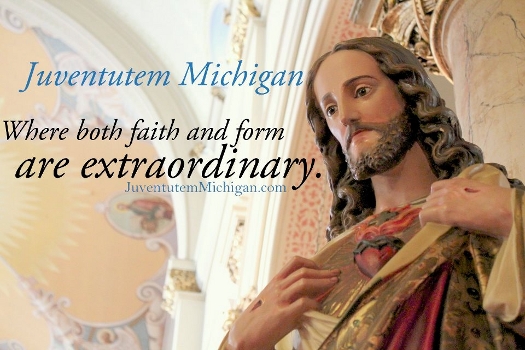
"I will go in unto the Altar of God
To God, Who giveth joy to my youth"
Tridentine Community News (March 31, 2013):
Religion and Art – Part 2 of 5
We continue our reprint of excerpts from an essay entitled Religion and Art by Fr. James Bellord, originally published in the 1910 book, A Pulpit Commentary on Catholic Teaching. The lessons contained are as relevant today as when they were first published.The Church of God is beautiful. “Thou art all fair, O my love, and there is no spot in thee” (Cant. iv, 7). She is so, as being one of the chief of God’s works, His special dwelling, and the manifestation of His perfections to men. Her doctrines are beautiful. The mysteries of Religion, the perfections of God, the life of Jesus Christ, the glory of His blessed Mother, the sacred Scriptures, have been the continual delight of thousands. The solemnities and ceremonies of divine worship in the Catholic Church, how impressive they are for their stateliness and beauty! Those who have come out of curiosity or hostility have often felt as if they had seen a glimpse of heaven. Whether splendid or poor, whether celebrated under the dome of the noblest Church in Christendom, or in a wooden hut, or a cavern beneath the ground, the worship of the Church is always stately. She cannot be frigid or lifeless on the one hand, or grotesque and fanatical on the other. Her action, like that of God, is always beautiful.Tridentine Masses This Coming Week
The Catholic religion does far more than any other to elevate and ennoble its followers’ characters and beautify their lives. Among the simple, the poor, the suffering, in remote corners of the world, among an industrious and Christian peasantry, there is found a spirit of contentment, courtesy, faith, patience, purity and fervor, which go to make up the most lovely of spectacles. Religion is the only antidote to that sordid selfishness, meanness, cruelty and lust, which stain our civilization with such unloveliness and produce such hideous results. It is being discovered that the creation of wealth degrades the workers, that mere knowledge and industry cannot elevate them, and that the sight of artistic and beautiful things is necessary to nourish the imagination and bring light into their lives. Of old the Catholic Church supplied this need of the mind with its sculptured cathedrals, its pictured glass, its wealth of statuary and painting, its histories of the saints, its festivals and bright processions, pulpit eloquence, and moving strains of music. The Reformation in some lands swept all this clean away, condemned it for the very reason which is its great merit, that its vividness and splendor appealed so much to the artistic sense and gratified the imagination. Time has brought its revenge. Legal holidays, popular concerts, and galleries of art, are an attempt, all too tardy, to supply the toiler with some few crumbs of the banquet of beauty which the Church of old dispensed abundantly to all.
I must quote in substance the words of a distinguished non-Catholic author on this point: “One method by which Christianity has labored to soften the characters of men has been through the imagination. Our imaginations affect our moral character, and, in the case of the poor especially, the cultivation of this part of our nature is of inestimable importance. Rooted to a single spot, excluded from most of the interests that animate the minds of other men, condemned to constant and plodding labor, their whole natures would have been hopelessly contracted, were there no sphere in which their imaginations could expand. Religion is the one romance of the poor. It alone extends the narrow horizon of their thoughts, supplies the images of their dreams, allures them to the supersensual and ideal. … It is the peculiarity of the Christian types that, while they have fascinated the imagination, they have also purified the heart.” He then recalls some of the externals of Catholic worship and concludes, “More than any spoken eloquence, more than any dogmatic teaching, they transform and subdue his character” (Lecky).
As Religion is so closely connected with uncreated Beauty and with the Beautiful in most of its forms, so it has been the chief agent in originating and inspiring Art. Faith has supplied noble images to the mind, and breadth and dignity to the characters of men, and these qualities have expressed themselves outwardly in architecture, painting, poetry, music, etc. From these arts, first employed in the service of Religion, all modern Art has sprung. Painting, decoration and sculpture began in the Roman catacombs with the endeavor to express Christian hope in symbols on the martyr’s tomb, and Christian reverence around the Altar of the Holy Sacrifice; and they were brought to perfection by the need of representing the doctrines of religion on the walls of Churches for the instruction of the faithful. The requirements of a new class of buildings for religious purposes created the glorious architecture of the Middle Ages, more living and progressive than the massive Egyptian, the stern Doric, and the elegant Corinthian; more capable of yielding in its details to the varying fancy of each nationality; more capable of development on many different lines, ranging from rude massiveness to fair delicacy, but always marked by truth and perfect taste. Musical notation was invented by Pope St. Gregory the Great, and later the simple but exquisite hymns of the liturgy were one by one composed.
- Mon. 04/01 7:00 PM: Low Mass at St. Josaphat (Easter Monday)
- Tue. 04/02 7:00 PM: High Mass at Assumption-Windsor (Easter Tuesday)
- Sun. 04/07 3:00 PM: High Mass at Assumption-Windsor (Divine Mercy Sunday/Low Sunday) – Confessions start at 2:00 PM, Chaplet of Divine Mercy at 3:00 PM, followed by Holy Mass



No comments:
Post a Comment